Exploring Al Maha: Dubai's Cultural and Architectural Gem
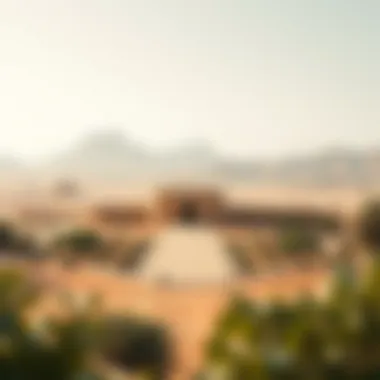
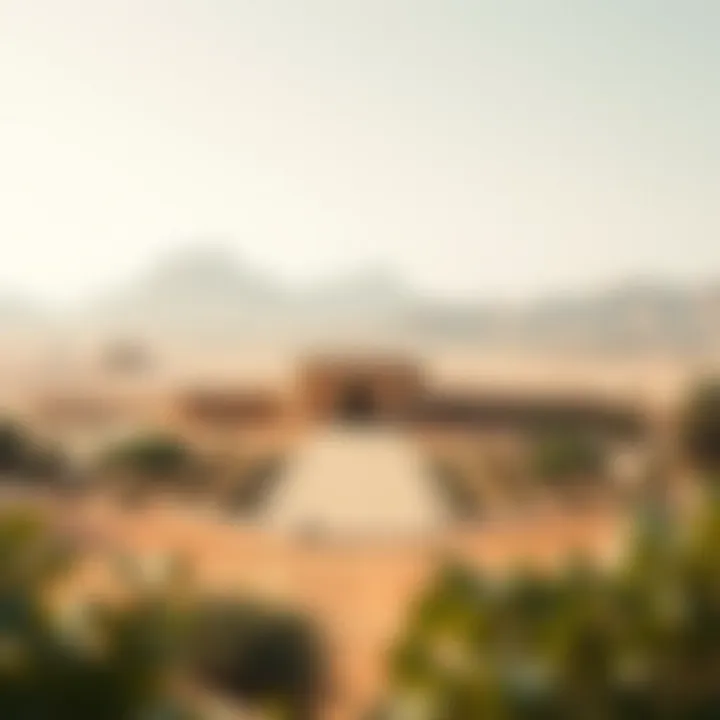
Intro
Al Maha, a cultural oasis in the heart of the Arabian desert, stands as a testament to Dubai's blend of tradition and modernity. This destination is more than just a luxury retreat; it is a microcosm of the United Arab Emirates' rich heritage and architectural prowess. Visitors to Al Maha are not merely exploring a resort; they're stepping into a narrative woven from the threads of history, nature, and design.
The architecture here is inspired by the traditional Bedouin encampments, but with a modern twist. Each suite offers a private pool and breathtaking views of the wild dunes and the Hajar Mountains, artfully merging comfort with nature. But beyond its beauty, Al Maha holds a special significance in terms of cultural and historical insights, capturing the essence of the area’s nomadic roots.
As we delve into this exploration, it is imperative to understand the influences shaping Al Maha today. From market trends to viable investment strategies, every aspect draws curious investors, residents, and travelers alike. This article aims to provide a clear lens through which to view Al Maha’s intricate layers, guiding your understanding of its role within Dubai's evolving landscape. Whether you’re seeking investment opportunities in this area or simply wish to experience its unique charm, each section will unveil elements that contribute to Al Maha's allure.
Read on to uncover the various dimensions that this unique location offers, and how it firmly places itself at the intersection of culture, architecture, and investment potential.
Prologue to Al Maha
Al Maha stands as a testament to the coalescence of tradition and modernity in Dubai's diverse tapestry. Nestled in the breathtaking Dubai Desert Conservation Reserve, this unique enclave offers a blend of cultural richness and architectural marvel that sets it apart from other luxury resorts in the region. Given its strategic location and distinctive features, understanding Al Maha is essential for investors, expats, and adventurers alike. This section lays the groundwork for appreciating the significance of Al Maha as a cultural and architectural destination while illuminating its relevance in today’s evolving urban landscape.
Historical Context
Al Maha’s history is woven into the broader narrative of Dubai itself. Originally a hunting reserve for the Sheikhs, the area has transformed into a symbol of conservation and preservation. The history of Al Maha is not just about its stunning backdrop; it also tells the story of the broader Emirates' dedication to safeguarding its natural and cultural heritage. Inspired by the Bedouin spirit, Al Maha was developed to celebrate the traditional way of life while providing an oasis of luxury. Collaborating with local conservationists, the resort emphasizes sustainable practices and the importance of maintaining local ecosystems.
The establishment of Al Maha in 1999 marked a pivotal moment, converting a once-neglected area into a flourishing example of eco-tourism. Visitors can witness the efforts to restore the native wildlife, including the Arabian oryx and other endangered species. The historical context makes Al Maha more than a mere luxury destination; it is a living museum of Dubai’s past and a reflective journey toward its future.
Significance in Dubai's Cultural Landscape
Dubai’s cultural landscape is a mosaic of influences, each contributing to the city’s unique identity. Al Maha plays a crucial role in this narrative, offering insights into the traditions and heritage of the region. As a luxury destination, it draws visitors who seek an immersive experience into the Emirati way of life, beyond the glitz and glamour typically associated with the city.
In a city teeming with modern skyscrapers and high-tech attractions, Al Maha is a breath of fresh air. It serves as a cultural anchor, showcasing important aspects of Emirati heritage through its architecture, design, and curated experiences. The resort's architecture is designed to echo traditional Bedouin tent structures, merging seamlessly with the natural environment, an essential principle in Emirati culture which emphasizes harmony with nature.
Moreover, Al Maha offers cultural programs, workshops, and artistic displays that shine a light on local traditions, from falconry to Bedouin storytelling. This reinforces not only its importance as a luxury retreat but also as an educational space promoting cultural awareness.
In summary, Al Maha represents a fusion of history, culture, and modernity within Dubai. Its significance lies not only in what it offers to tourists but also in how it embodies the ethos of Dubai’s commitment to preserving its roots while evolving into a global metropolis.
Architectural Features
The architectural features of Al Maha are central to its identity, intertwining Emirati heritage with contemporary design. This remarkable blend is not merely a visual treat but a profound commentary on how architecture can narrate cultural stories while embracing modern innovations.
Design Philosophy
At the heart of Al Maha's architectural practice lies a design philosophy that respects the environment and cultural significance. The ethos here is to create structures that are not just functional but also symbols of the rich Bedouin heritage of the United Arab Emirates. The inspiration drawn from traditional tents, known as "bayt al sha'ar," is evident in the shape and layout of the luxurious suites, presenting elegance that feels at home amidst the desert backdrop. Each suite's design reflects a commitment to authenticity and contextuality, with careful consideration for local culture and architectural language.
The use of local craftsmanship strengthens connections to tradition, offering visitors a chance to immerse themselves in the essence of Emirati culture. The visitor experience is thus elevated, enabling one to appreciate a lifestyle that has been honed over centuries. Al Maha is a living example of architectural storytelling, where every corner speaks volumes about its origins.
Materials and Techniques
When it comes to materials, Al Maha does not hold back on sourcing natural textures that harmonize with the surrounding environment. Think of materials like sandstone and timber, which are quintessentially Arabian and provide not only aesthetic appeal but also thermal comfort, a key factor in desert architecture.
The construction practices are deeply rooted in sustainability. For instance, the roofs are designed to minimize heat absorption while maximizing airflow, thus reducing the reliance on artificial cooling. This approach is strategic, given the vigorous climate of the region, where summer temperatures can soar.
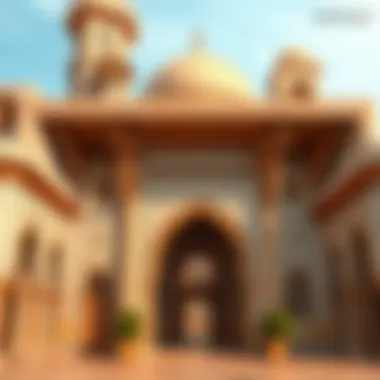
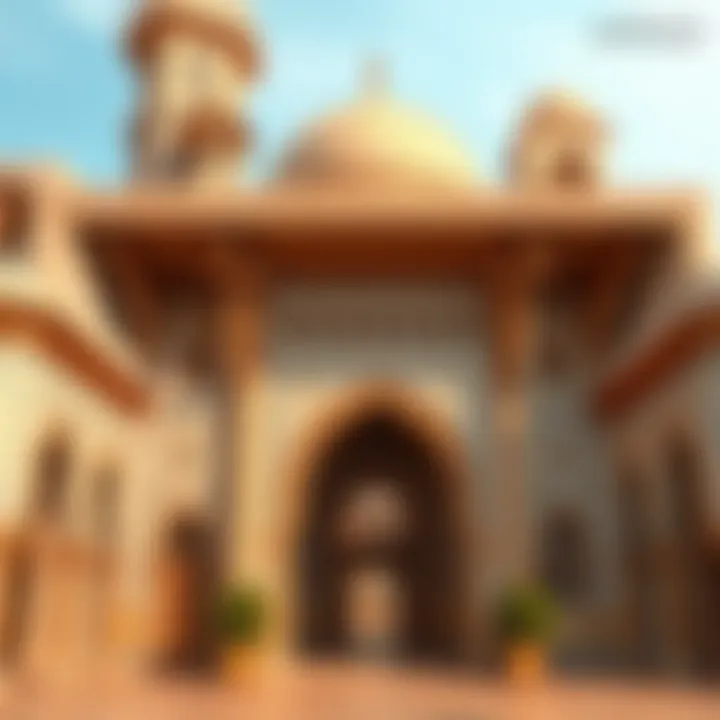
Furthermore, the interiors often feature local artisans' handiwork, showcasing Arabian mashrabiya (wood latticework) and intricate tile patterns, which echo the region's artistic heritage. This meticulous attention to detail stands as a testament to the dedication towards honouring the local culture while also addressing modern demands.
Integration with Nature
Al Maha's architectural features are not just about aesthetics; they are about being one with nature. The structures are carefully positioned to minimize disturbance to the natural landscape, allowing views of the stunning desert and wildlife to be an integral part of the experience. Large windows and terraces blur the boundaries between indoor and outdoor spaces, inviting the breathtaking desert vistas right into the living area.
Visitors can enjoy private infinity pools overlooking the dunes, making it feel as if they are floating amidst the sand. The use of earth tones in the buildings helps them blend seamlessly into the landscape, reinforcing the idea of harmony with nature.
"The way architecture interacts with its natural surroundings tells a story of respect and understanding of the ecosystem, a necessity in a climate as unique as the Arabian Desert."
Key Attractions and Activities
Exploring Al Maha offers a unique array of attractions and activities that set it apart in Dubai's rich tapestry of cultural experiences. From immersive cultural undertakings to leisure activities and wildlife observation, each element contributes to an understanding of this oasis in the desert.
Cultural Experiences
Al Maha is steeped in rich cultural significance. Visitors can engage in traditional crafts, such as pottery and weaving, offered through workshops led by local artisans. These hands-on experiments foster a connection between the past and present, giving insight into the heritage of the Bedouins, the native people of the region.
Additionally, narrated tours about the history and culture of Al Maha deepen the visitor's understanding. These narratives not only celebrate the local environment but also connect with rich stories of the Emirati culture.
Highlights include:
- Cultural Workshops: Participate in traditional craft-making sessions.
- Bedouin Heritage Tours: Learn about the history of the desert inhabitants.
- Arabian Nights: Experience traditional music and dance performances under the stars.
Adventure and Leisure
For those drawn to thrill-seeking, Al Maha provides an exciting playground of outdoor pursuits. From desert safaris to camel riding, adventure abounds in a setting that pairs breathtaking views with exhilarating experiences.
A must-try is the exhilarating dune bashing, where 4x4 vehicles navigate the sweeping dunes, offering an adrenaline rush unlike any other. For a more leisurely pace, nature walks allow visitors to absorb stunning landscapes while encountering local flora and fauna.
Key activities include:
- Dune Bashing: Venture across rolling sand dunes in 4x4s.
- Camel Trekking: Experience the desert as ancient travelers did.
- Desert Photography: Capture stunning sunsets and rolling dunes.
Wildlife and Nature Observation
The pristine landscape surrounding Al Maha is not just visually captivating; it is a sanctuary for diverse wildlife. The conservation efforts here allow visitors to observe creatures that have made this ecosystem their home.
Wildlife enthusiasts can spot the Arabian oryx, a symbol of national pride, along with various birds and lizards. Binoculars are a must for bird watchers who may catch sight of hoopoes and other migratory birds.
Some activities to consider:
- Wildlife Safaris: Guided tours to observe local fauna.
- Birdwatching Sessions: Spot diverse endangered species.
- Nature Trails: Stroll through habitats and learn about ecosystems.
"Exploring the diverse attractions and activities at Al Maha deepens one's appreciation for both history and the natural beauty of Dubai's desert landscape."
This extraordinary variety of attractions ensures that visitors leave Al Maha not merely as tourists, but as immersed participants in a living tableau of Emirati culture, adventure, and wildlife.
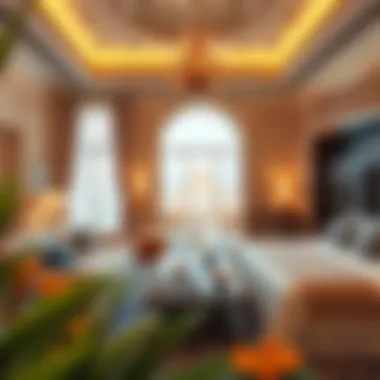

Visitor Insights
Understanding the visitor insights of Al Maha is essential to grasp its allure and significance in Dubai's panorama. This domain serves not just as a destination but as a living tapestry woven with the threads of cultural experiences, nature, and an ambitious vision for future growth. Analyzing feedback from travelers offers prospective investors and visitors a critical gauge of how Al Maha is perceived and enjoyed, providing valuable context around the benefits and any potential considerations that may arise from a visit.
Traveler Experience and Feedback
Like flipping through a vibrant photo album, travelers’ experiences at Al Maha reveal much about its character. Review platforms and social media posts are rich in anecdotes that illuminate both the enchantment and the hurdles of visiting this unique oasis. Visitors often speak about the remarkable blend of luxury and tradition, a dance between comfortable modernity and the whispers of ancient cultures.
"Staying at Al Maha was like stepping into a dream. The sunsets over the desert were surreal, and the architecture seamlessly blended into the surroundings."
— A recent visitor’s review
Many travelers highlight the hospitality of the staff at the Al Maha Resort as a standout feature. Guests frequently mention personalized services that add a special touch—cultural activities designed to immerse visitors in the Emirati way of life.
However, feedback sometimes reveals areas for improvement. Some visitors have voiced concerns regarding the transportation options available to the resort, citing that while taxis are prevalent in Dubai, accessing Al Maha specifically could involve planning due to its relative remoteness. Therefore, understanding traveler reviews provides potential guests with a realistic picture of the experience awaiting them.
Accessibility Considerations
Accessibility is an essential factor to consider for both visitors and those looking to invest in the Al Maha region. The remote location, nestled away from the high-energy bustle of urban Dubai, adds a layer of privacy but can also pose challenges. While the journey to Al Maha is often described as serene—offering stunning views of the changing landscapes—it is wise to plan ahead.
Transport options currently include:
- Private transport: Renting a car gives travelers the freedom to explore the wider area at their convenience.
- Shuttle services: Many hotels in Dubai offer shuttle services, but confirming schedules can prevent any misadventures.
- Ride-hailing apps: Utilizing apps like Uber can simplify getting from the city, although it may take longer during peak traffic.
It's also important to note that Al Maha's infrastructure accommodates individuals with disabilities by providing accessible facilities within the resort. This consideration reflects a commitment to inclusivity, appealing to a broader audience.
Ultimately, understanding visitor insights underscores the importance of anticipating both the exceptional and the unexpected. This knowledge enriches the experience and supports informed decisions by potential investors and travelers alike, solidifying Al Maha’s reputation as a remarkable destination in Dubai.
Impact on Real Estate
Analyzing the impact of Al Maha on real estate reveals how this unique destination shapes not only its immediate vicinity but also the wider Dubai landscape. The exquisite blend of culture and architecture found within Al Maha attracts varied demographics including investors, expatriates, and local buyers looking for luxury experiences interwoven with nature. The presence of high-end accommodations and facilities ensures that Al Maha is not just a fleeting attraction, but a significant player in the real estate market.
One noteworthy aspect is how Al Maha's architecture and design set a benchmark for luxury developments in Dubai. Its distinct aesthetic, characterized by traditional Arabian influences, creates an ambiance that exudes both opulence and authenticity. This has led to other properties in Dubai seeking to replicate this touch of heritage while also incorporating modern conveniences.
Moreover, investing in properties near Al Maha offers substantial benefits. Buyers are often drawn not just to the beauty of the immediate surroundings but also to the increased demand from touristic interest. Properties become more sought after when they're closely linked to a cultural treasure like Al Maha. This contributes to a greater appreciation in property values over time, making it a wise investment choice.
Additionally, Al Maha's integration with nature—boasting sprawling desert landscapes and stunning wildlife—adds another layer of appeal for real estate investment. Such characteristics attract eco-conscious buyers and luxury seekers alike.
- In summary:
- Al Maha elevates property values in Dubai through its unique branding.
- It sets a trend for luxury design that constituents in the region are keen to follow.
- The area’s connection to nature enhances its allure for buyers.
"Investing near cultural landmarks like Al Maha can offer significant returns, both in terms of property value and quality of life."
Market Trends Surrounding Al Maha
In recent years, market trends surrounding Al Maha have reflected a keen interest from both investors and buyers. As Al Maha gains recognition as a cultural hub, the demand for real estate in adjacent areas has surged. Analysts have observed that property prices in close proximity to Al Maha often outperform similar developments further afield. This phenomenon is largely driven by its appeal as both a residential locale and a destination for tourists and cultural enthusiasts.
Current trends suggest a shift towards luxury sustainable living. Many new developments are focusing on eco-friendly practices, mirroring Al Maha’s commitment to maintaining its natural environment. With regulatory frameworks increasingly supporting sustainable architecture, potential investors should take note of how these patterns shape the market.

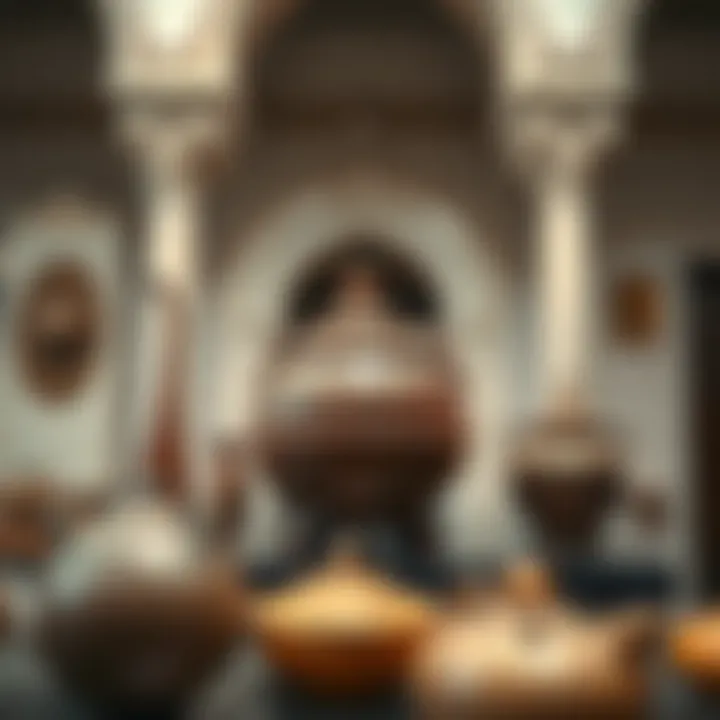
- Trends include:
- Increased interest in properties that offer a blend of luxury and sustainability.
- Growth in demand for high-end rentals due to tourist influx.
- Organizational development initiatives focusing on enhancing cultural experiences in the area.
Investment Opportunities
Investors with an eye on the future should seriously consider what Al Maha represents in terms of opportunity. As Dubai continues to push boundaries in tourism and cultural integration, the need for real estate investments that cater to these trends becomes essential.
The interest in tourism and cultural resonance leads to numerous investment avenues:
- High-end resorts and hotels that blend in with the natural surroundings.
- Boutique retail spaces on the periphery that offer artisan goods promoting local culture.
- Residential complexes that appeal to expats wanting a slice of cultural life while enjoying luxurious amenities.
- Eco-friendly projects that attract environmentally-conscious buyers looking for sustainable investments.
Future Developments
The section on Future Developments holds a crucial space in this exploration of Al Maha, as it sheds light on the anticipated evolution of this unique area. The still budding potentials in terms of infrastructure, cultural additions, and environmental considerations highlight how Al Maha is positioned for growth while remaining rooted in its rich heritage. The key here is to understand that future developments can shape not only the landscape but also how residents and visitors engage with this cultural jewel.
Projected Growth of the Area
In recent years, Al Maha has witnessed steady growth in real estate and tourism, signaling a promising trajectory. As more people seek luxurious yet cultural experiences, Al Maha is likely to attract a host of investors interested in tapping into the flourishing market. This region's approach, marrying tradition with modernity, has captured the imagination of many.
A number of factors contribute to the projected growth:
- Government Support: The Dubai government continues to back developments that enhance cultural tourism.
- Rising Interest in Eco-Tourism: More travelers seek sustainable travel options; Al Maha fits the bill perfectly.
- Infrastructural Investments: Upgrades in transportation and amenities are key components drawing in people.
Anticipated developments will not only create jobs and stimulate the economy but will also open new avenues for projects centered around art, culture, and sustainability. Property values are predicted to increase as the area thrives, making it an attractive opportunity for investors, residents, and even expatriates looking to settle and invest in a place that tells a story.
Sustainability Initiatives
A cornerstone of future developments in Al Maha is sustainability, with various initiatives in the pipeline aimed at preserving the environment. It’s all about ensuring that progress doesn’t come at the expense of nature. Local stakeholders are increasingly recognizing the need for responsible development practices to maintain the ecological balance that has become a hallmark of the area.
Some notable initiatives include:
- Water Conservation Programs: Leveraging modern irrigation systems to lessen water wastage.
- Renewable Energy Use: Solar panels and other green technologies are being incorporated into new projects to reduce carbon footprints.
- Community Involvement in Conservation: Engaging local communities in preserving the natural landscape and promoting education around sustainability practices.
By embedding sustainability into the core of future planning, Al Maha aims to serve as a model for other regions, showcasing that luxury and responsibility can coexist harmoniously. It’s an exciting time as the long-term vision of an eco-conscious and culturally rich destination gradually materializes.
The End
The conclusion of this article serves as a crucial synthesis of Al Maha's significance in shaping both cultural identity and economic prospects in Dubai. Through this exploration, we see how Al Maha is not just a resort but a living reflection of the blend between tradition and modernity.
Reflecting on Al Maha's Role in Dubai's Identity
Al Maha acts like a bridge between the rich traditions of the UAE and the quicksilver lifestyle of modern Dubai. Nestled within the striking dunes, it creates a sense of place that resonates with visitors and locals alike. By showcasing Emirati heritage through art, culinary experiences, and architecture, the resort preserves the essence of the nation.
In many ways, Al Maha embodies what it means to be a part of Dubai's evolving narrative. While the skyline is dotted with futuristic structures, this resort tells a story of the past—one that is crucial for understanding the present and imagining the future. It invites guests to dive deep into the cultural waters and encourages them to appreciate local customs. In a world that's fast-paced, places like Al Maha provide a much-needed pause, allowing reflection on the true spirit of Dubai.
"Cultural tourism blooms where heritage meets modern luxury, morphing into experiences that transcend simple leisure."
The Future of Cultural Tourism in Dubai
Looking ahead, the potential for cultural tourism in Dubai is immense. With places like Al Maha setting a template for success, other developments are likely to follow suit—balancing luxury with authenticity, showcasing the UAE's heritage without sacrificing modern comforts. The focus may shift toward creating experiences that entice travelers to stay longer and engage more deeply with the local culture.
As international interest in the region rises, investors and stakeholders are in a prime position to capitalize on the emerging trends. The affordability of heritage-infused experiences could cater to a wide range of visitors, making Dubai not just a stopover, but a cultural destination.



